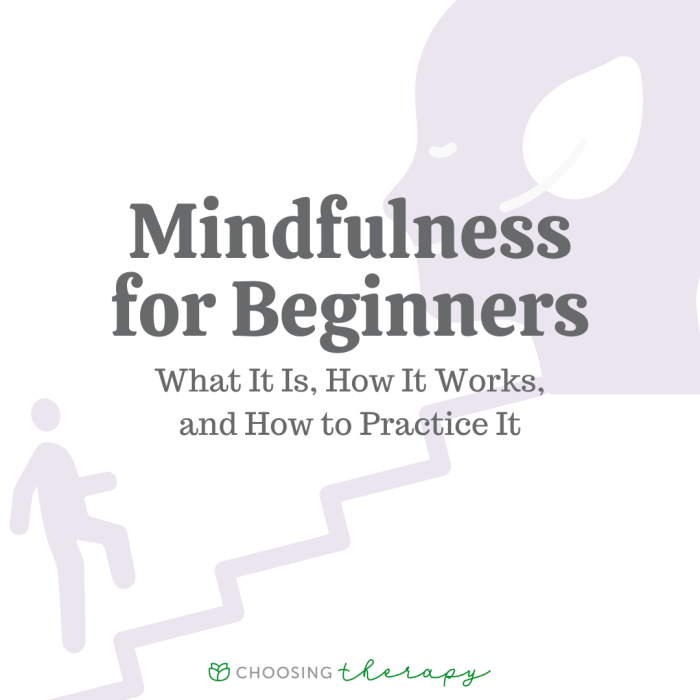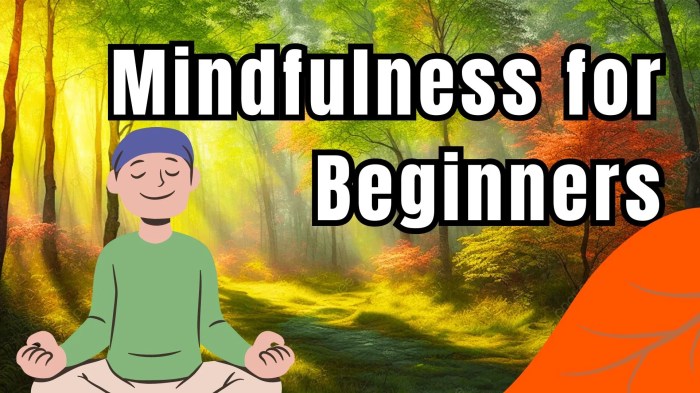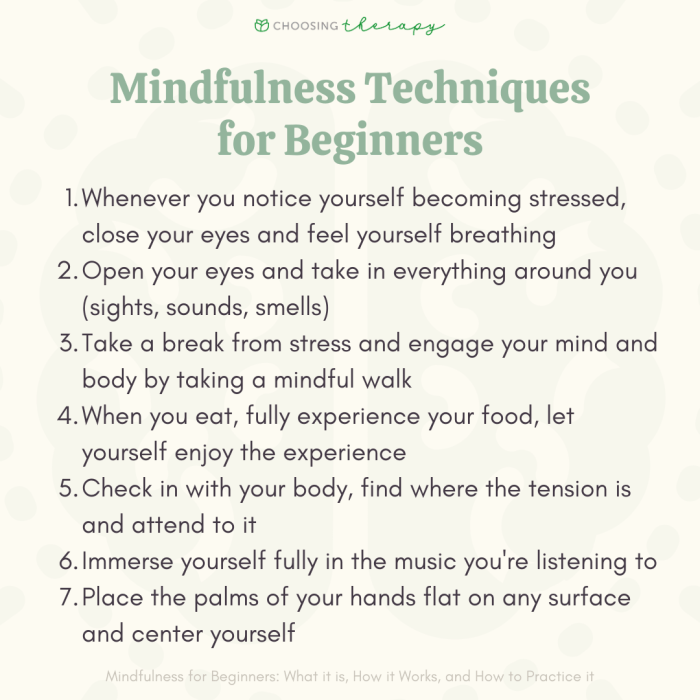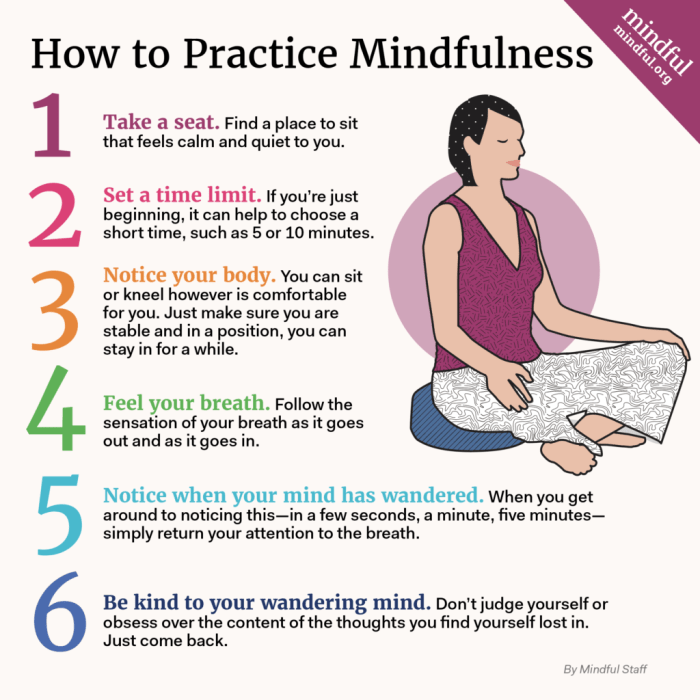Mindfulness for Beginners: A Gentle Guide to Inner Peace

Mindfulness for beginners sets the stage for this enthralling narrative, offering readers a glimpse into a practice that can cultivate inner peace and well-being. Mindfulness, a simple yet powerful technique, involves paying attention to the present moment without judgment. This guide will explore the fundamentals of mindfulness, providing practical tips and strategies to help you embark on your journey towards greater awareness and serenity.
You’ll discover the core principles of mindfulness, learn about its numerous benefits, and understand the difference between mindfulness and meditation. From incorporating mindfulness into your daily routine to overcoming common challenges, this guide will equip you with the knowledge and tools to cultivate a mindful lifestyle.
Introduction to Mindfulness

Mindfulness is a practice that involves paying attention to the present moment without judgment. It is a way of being fully aware of your thoughts, feelings, sensations, and surroundings without getting carried away. Mindfulness is not about emptying your mind or achieving a state of bliss, but rather about observing your experiences with curiosity and acceptance. Mindfulness can be a valuable tool for beginners looking to improve their well-being and enhance their overall quality of life.
It can help you manage stress, reduce anxiety, increase self-awareness, and foster greater emotional regulation.
The Core Principles of Mindfulness
The practice of mindfulness is grounded in several core principles:
- Non-judgmental observation: This principle encourages observing your thoughts, feelings, and sensations without labeling them as good or bad, right or wrong. It’s about simply acknowledging them without getting caught up in them.
- Acceptance: Accepting your experiences as they are, without trying to change or resist them. This includes accepting pleasant and unpleasant experiences, and recognizing that they are all part of life.
- Present moment focus: Bringing your attention to the here and now, rather than dwelling on the past or worrying about the future. This involves focusing on your breath, your senses, and your body in the present moment.
Benefits of Practicing Mindfulness for Beginners
There are numerous benefits to practicing mindfulness, especially for beginners:
- Stress reduction: Mindfulness can help calm the nervous system, reducing stress levels and promoting relaxation. It allows you to step back from stressful thoughts and emotions, creating a sense of calm and clarity.
- Improved focus and concentration: By training your mind to stay present, mindfulness can enhance your ability to focus and concentrate on tasks. It can help you become more aware of distractions and better manage your attention.
- Increased self-awareness: Mindfulness cultivates greater self-awareness, allowing you to become more attuned to your thoughts, feelings, and bodily sensations. This awareness can help you better understand yourself and your reactions to different situations.
- Emotional regulation: Mindfulness can help you develop greater emotional regulation skills. By observing your emotions without judgment, you can learn to manage them more effectively, reducing impulsive reactions and promoting emotional stability.
Mindfulness vs. Meditation
While mindfulness and meditation are often used interchangeably, there are some key differences:
- Mindfulness is a broader concept that encompasses paying attention to the present moment without judgment, while meditation is a specific practice that involves focusing the mind on a particular object, such as the breath, a mantra, or a visualization.
- Mindfulness can be practiced in everyday activities, such as walking, eating, or listening to music, while meditation typically involves sitting or lying down in a quiet environment.
- Mindfulness can be practiced for short periods, even just a few minutes, while meditation is often practiced for longer durations, ranging from 10 minutes to an hour or more.
Getting Started with Mindfulness
Mindfulness is a practice that can be incorporated into your daily life to cultivate awareness and reduce stress. It involves paying attention to the present moment without judgment.
Creating a Mindful Practice
It is essential to establish a consistent routine to develop a mindful practice. This can involve dedicating a specific time each day for meditation or incorporating mindful moments into your daily activities.
- Set aside time: Dedicate a few minutes each day to practice mindfulness. Start with 5-10 minutes and gradually increase the duration as you become more comfortable.
- Choose a comfortable space: Find a quiet and comfortable place where you can sit or lie down without distractions. This could be your bedroom, a park, or even a quiet corner in your office.
- Focus on your breath: Pay attention to the sensation of your breath as it enters and leaves your body. Notice the rise and fall of your chest or abdomen.
- Observe your thoughts and feelings: As you become more aware of your breath, you may notice thoughts and feelings arising. Acknowledge them without judgment and gently return your attention to your breath.
- Practice body scan meditation: This involves bringing your awareness to different parts of your body, starting from your toes and moving up to your head. Notice any sensations, such as warmth, tingling, or tightness.
- Engage in mindful activities: You can practice mindfulness while performing everyday activities such as eating, walking, or showering. Pay attention to the sensations, sounds, and sights associated with these activities.
Guided Meditation for Beginners
Guided meditation can be a helpful tool for beginners. It provides structure and guidance, making it easier to focus your attention.
“Find a quiet place where you can sit comfortably. Close your eyes and bring your attention to your breath. Notice the sensation of your breath as it enters and leaves your body. You may notice your breath is shallow or deep, fast or slow. Simply observe it without judgment. As you focus on your breath, you may notice thoughts and feelings arising. Acknowledge them without judgment and gently return your attention to your breath. Continue to focus on your breath for 5-10 minutes.”
Finding a Quiet and Comfortable Space
A quiet and comfortable space is essential for practicing mindfulness. It allows you to focus your attention without distractions.
- Choose a quiet environment: Find a place where you won’t be interrupted by noise or other distractions. This could be your bedroom, a park, or a quiet corner in your office.
- Create a comfortable setting: Make sure you have a comfortable place to sit or lie down. You may want to use a cushion or blanket to support your body.
- Minimize distractions: Turn off your phone, TV, and any other devices that could distract you. You may also want to close your eyes or use a blindfold to block out visual distractions.
Mindfulness Techniques for Beginners: Mindfulness For Beginners

Mindfulness is a practice that can be learned and cultivated through various techniques. These techniques can help you develop a greater awareness of the present moment, reducing stress and improving overall well-being. Here are some beginner-friendly techniques to explore:
Mindful Breathing
Mindful breathing is a simple yet powerful technique that involves focusing your attention on your breath. It is a foundational practice for cultivating mindfulness.
- Find a comfortable position. Sit or lie down in a relaxed position where you can comfortably focus on your breath.
- Bring your attention to your breath. Notice the natural rhythm of your breath as you inhale and exhale.
- Observe your breath without judgment. Simply observe the sensations of your breath as it enters and leaves your body.Notice the rise and fall of your chest or abdomen.
- If your mind wanders, gently guide it back to your breath. It is natural for your mind to wander. When you notice your mind has drifted, simply acknowledge it without judgment and gently redirect your attention back to your breath.
Body Scan Meditation
Body scan meditation involves systematically bringing your attention to different parts of your body. It helps to increase body awareness and develop a greater sense of presence.
- Find a comfortable position. Lie down or sit in a comfortable position where you can relax your body.
- Bring your attention to your breath. Take a few moments to focus on your breath as you inhale and exhale.
- Start with your toes. Bring your attention to your toes. Notice any sensations in your toes, such as warmth, tingling, or pressure.
- Move your attention slowly up your body. Gradually shift your attention to your feet, ankles, calves, and so on, moving slowly up your body.
- Observe sensations without judgment. As you scan your body, notice any sensations you experience. There is no need to change or control these sensations. Simply observe them with curiosity.
Mindful Walking
Mindful walking is a simple practice that involves paying attention to the sensations of walking. It can be a great way to bring mindfulness into your daily routine.
- Find a quiet space. Choose a place where you can walk without distractions.
- Begin walking at a slow pace. Start by taking slow, deliberate steps.
- Focus on the sensations of walking. Pay attention to the feeling of your feet on the ground, the movement of your legs, and the rhythm of your breath.
- Observe your surroundings. Notice the sights, sounds, and smells around you.
- Maintain a gentle awareness. If your mind wanders, gently guide it back to the sensations of walking.
Overcoming Challenges in Mindfulness Practice

Mindfulness is a skill that takes time and effort to develop. It’s natural to encounter challenges along the way, especially when you’re first starting. These challenges can be frustrating, but they are also opportunities for growth and learning.
Strategies for Dealing with Distractions and Negative Thoughts
Distractions and negative thoughts are common obstacles to mindfulness practice. These are simply mental patterns that arise in our minds. The key is to observe them without judgment and gently guide our attention back to the present moment.
- Acknowledge the thought or distraction. Don’t try to suppress it or push it away. Simply notice it without judgment. You can say to yourself, “I’m noticing a thought about…” or “I’m feeling…”
- Gently redirect your attention. Once you’ve acknowledged the distraction, gently guide your attention back to your breath, your body sensations, or the object of your focus. You can use a mantra or visualization to help you refocus.
- Practice patience and kindness. Mindfulness is not about achieving a state of perfect quiet. It’s about learning to be present with whatever arises in your mind and body. Be patient with yourself and practice kindness towards your thoughts and feelings.
The Importance of Patience and Consistency in Practice
Patience and consistency are essential for developing a regular mindfulness practice. It takes time and effort to train your mind to be present and aware.
- Start small and be consistent. Even a few minutes of practice each day can make a difference. Choose a time that works for you and stick to it as much as possible.
- Don’t get discouraged by setbacks. There will be times when you find it difficult to focus or when your mind wanders. That’s normal. Just gently guide your attention back to the present moment and continue practicing.
- Celebrate your progress. Acknowledge your efforts and celebrate your successes, no matter how small they may seem. Every moment of mindfulness is a step in the right direction.
Integrating Mindfulness into Daily Life
Mindfulness is not just a practice for meditation sessions; it’s a skill that can be woven into the fabric of everyday life. By cultivating mindfulness in your daily activities, you can experience greater peace, clarity, and connection.
Creating a Mindfulness Plan, Mindfulness for Beginners
To effectively integrate mindfulness into your daily life, it’s helpful to have a plan. Here’s a step-by-step approach:
- Identify Key Areas: Begin by identifying the areas of your life where you’d like to bring more mindfulness. This could include work, relationships, leisure activities, or even routine tasks like eating or showering.
- Choose Activities: Select specific activities within each area that you can practice mindfulness during. For example, at work, you could practice mindful breathing during breaks or engage in mindful walking during your commute.
- Set Realistic Goals: Start with small, achievable goals. Instead of aiming to be mindful all the time, begin with a few minutes each day or a specific activity.
- Be Patient and Kind: Mindfulness is a practice, not a destination. There will be times when you forget or struggle to stay mindful. Be patient with yourself and don’t get discouraged.
- Track Your Progress: Keep a journal or use a mindfulness app to track your progress. This can help you identify areas where you’re succeeding and areas where you need to focus more.
Mindfulness in Work
Mindfulness can enhance productivity, reduce stress, and improve relationships at work. Here are some ways to incorporate mindfulness into your work life:
- Mindful Breathing: Take a few minutes throughout the day to focus on your breath. This can help to calm your mind and reduce stress.
- Mindful Walking: Instead of rushing through your commute, take a few minutes to walk mindfully, paying attention to the sensations of your feet on the ground, the sounds around you, and the sights you see.
- Mindful Meetings: During meetings, try to focus on the present moment, listening attentively to others and expressing yourself clearly.
- Mindful Emailing: Instead of rushing through emails, take a moment to read and respond thoughtfully.
Mindfulness in Relationships
Mindfulness can deepen your connection with loved ones and enhance communication. Here are some ways to practice mindfulness in your relationships:
- Mindful Listening: When someone is talking to you, try to truly listen to what they are saying, without interrupting or formulating your response. Pay attention to their body language and tone of voice.
- Mindful Communication: Before speaking, take a moment to reflect on what you want to say and how you want to say it. Express yourself clearly and respectfully.
- Mindful Touch: When you hug or hold someone, try to be fully present in the moment, feeling the warmth of their body and the connection between you.
- Mindful Dates: When you’re spending time with your partner, try to put away your phones and other distractions. Focus on being fully present with them, enjoying each other’s company.
Mindfulness in Leisure
Mindfulness can enrich your leisure activities, allowing you to experience them more fully. Here are some ways to practice mindfulness during your free time:
- Mindful Eating: Pay attention to the taste, texture, and smell of your food. Savor each bite and enjoy the experience of eating.
- Mindful Walking: Go for a walk in nature, paying attention to the sights, sounds, and smells around you.
- Mindful Exercise: Focus on the sensations of your body as you move. Notice how your muscles feel, how your breath changes, and how your mind feels as you exercise.
- Mindful Reading: Immerse yourself in the book you’re reading, paying attention to the words, the characters, and the story unfolding.
Final Summary

Embracing mindfulness is like planting a seed of peace within yourself. It’s a journey of self-discovery, a path toward greater clarity and resilience. As you delve deeper into the practice, you’ll experience a profound shift in your perspective, fostering a greater sense of presence, compassion, and acceptance.
Mindfulness isn’t about achieving perfection, but rather about embracing the beauty and imperfection of each moment. With consistent practice, you’ll find yourself more attuned to your thoughts, feelings, and surroundings, leading to a more fulfilling and balanced life.
Comments are closed.